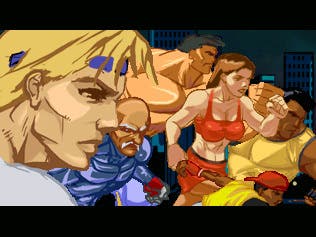The Tao of Beat-'em-ups
Part 2: A fight is not won by one punch or kick. Fighting from '85 to '93.
The videogame market - which was still reeling from a US economic collapse in 1983 - was in a position to suffer once again. A glut of fighting games fought for shoulder space on the busy arcade floor, but operator takings still hadn't recovered and profit margins were thin. Development times were cut with a rusty hacksaw, and trite tedium began to sneak into the fighting game's realm.
Despite the legacy it founded, Capcom's terrific yet badly executed design for 1987's Street Fighter was a depressing failure. Gamers wanted to like it, and when a fireball first flew inadvertently from Ryu's kung fu grip it was a rapturous event, but the pressure-sensitive (and usually knackered) button, coupled with stilted, awkward gameplay turned fighting fans off the tournament games and toward the scroller.
It was precisely this kind of swollen industry baggage that had pushed the US games market into such severe recession, but the beat-'em-up managed to survive dangerously similar mistakes thanks to a steady supply of high quality titles balancing out the scales. For every Dynamite Dux, there was a Final Fight; for every DJ Boy, there was a Golden Axe. The genre walked a razor's edge for almost five years - teetering on the verge of collapse with a protracted glut of banality, then wrenching itself back into glory with another instant classic.
Naturally, such a tumultuous existence spilled over into the home market, which played equally cruel tricks on the addicted beat-'em-up punter. As 16-bit machines began to filter through the technology barrier, the home games market unleashed the true fighting experience into our living rooms while 8-bit campaigners compiled their years of experience into squeezing every last possibility from the limited silicon.
"Moving, be like water. Still, be like a mirror. Respond like an echo. " - Bruce Lee

The wealth of arcade fighting titles put gamers on pins as they waited for conversions, only to be smacked in the face and reverse-suplexed like a generic punk thug when it finally arrived. Ports of the immortal coin-op classic, Double Dragon, were an insult to the impassioned gamers, while others failed to appear at all. The only hope for front-room fighting games was in the new intellectual property of a few dedicated developers - ones who understood the thrill of unconscionable simulated violence.
A few average experiments in 8-bit fighting, like Uchi Mata and Way of the Tiger, kept the genre on a low heat, but there was little to contest the arcade's year of resounding success. Then, just as Technos had returned to the arcades in triumph, Archer MacLean leapt back into the home computing ring. His sequel to the pivotal one-on-one game International Karate (which, to be fair, saw a success that was pretty much restricted to the C64), took a similar step toward gameplay revolution that Double Dragon had just achieved - a third combatant in the typical tournament fighter.
Of course, everyone knows there was nothing remotely typical about IK+. Let's face it, any game that factors in the ability to have the characters drop their trollies on command was going to be a success among violence-addicted nut cases. But MacLean crafted a magnificent work of tightly refined code kung fu, liquid smooth animation and emphatically playable action - one of the rarest of fighting game experiments that paid off immensely.
The success of Ocean's Renegade conversion, coupled with the dismal failure of the Double Dragon ports (and the developer's astute contract clause which granted it the rights to make its own sequel) paved the way for the finest example of an 8-bit scrolling beat-'em-up. Where the C64 had International Karate, the Spectrum had Target: Renegade - a superb, and decidedly UK-centric, two-player fighting game that simultaneously saved the sanity of beat-'em-up fans while robbing them of any spare time. The home computer-only sequel to Technos' arcade classic was timed perfectly to reassure 8-bit owners that beat-'em-ups were possible - even if the classics weren't coming home.

By this point, consoles were being designed with fighting games in mind, and were ready to join powerhouse computers like the Amiga and ST in filling our homes with wonderful, unrestrained violence.
The gaming industry had been dominated. It was now a fighting game industry, with a few platformers and shumps thrown in for the kids. It had risen to a deafening, deadly crescendo of breaking bones, pummelled flesh and a million 10p pieces hitting an overfull coin box.
"We all have time to spend or waste, and it is our decision what to do with it. But once passed, it is gone forever." - Bruce Lee
Every eventuality was explored, exploited and executed. From brilliant re-imaginings of the original Kung Fu Master (such as Splatterhouse and Vigilante) to 16-bit computer-based extravaganzas like Body Blows and Panza's Kickboxing - the gaming world was throwing punches in every direction.